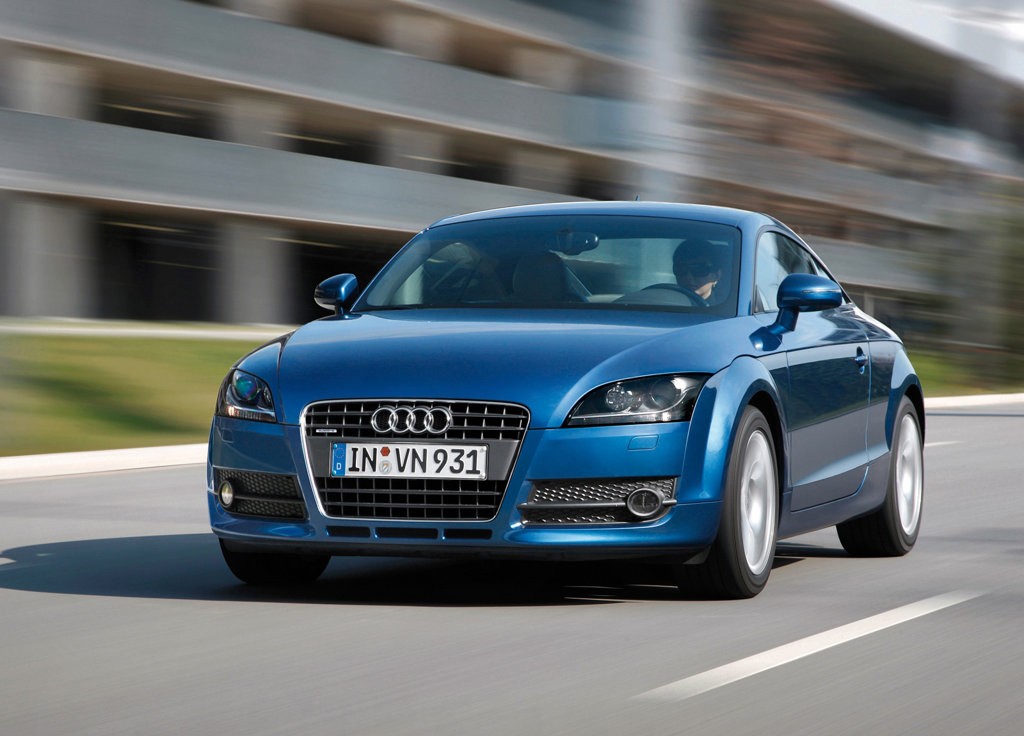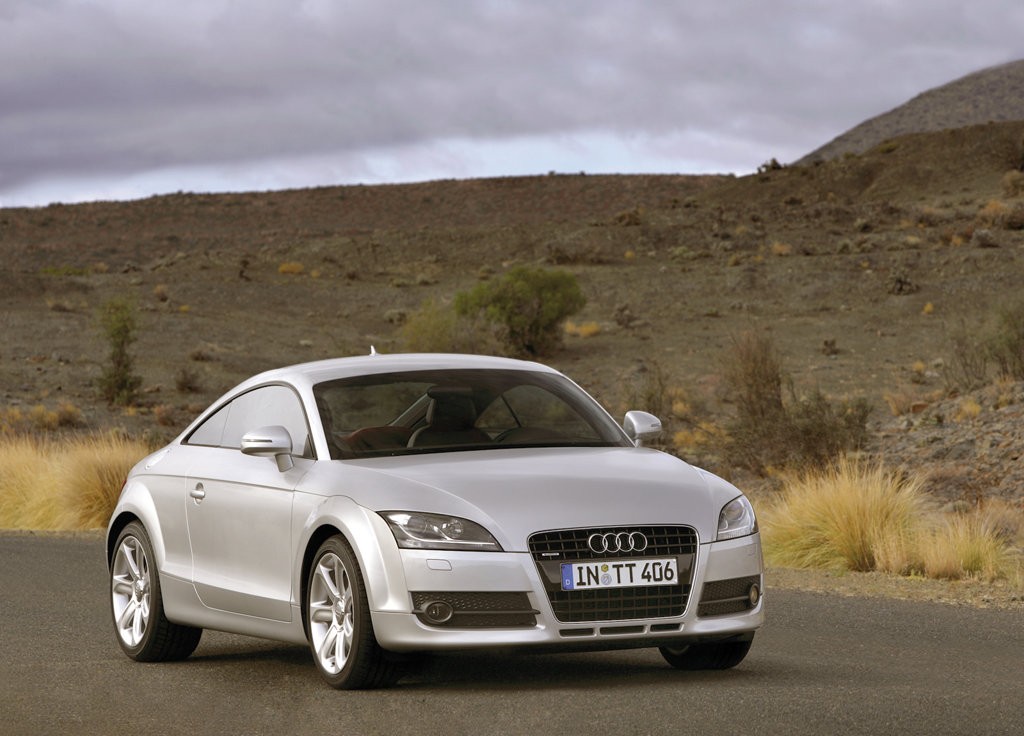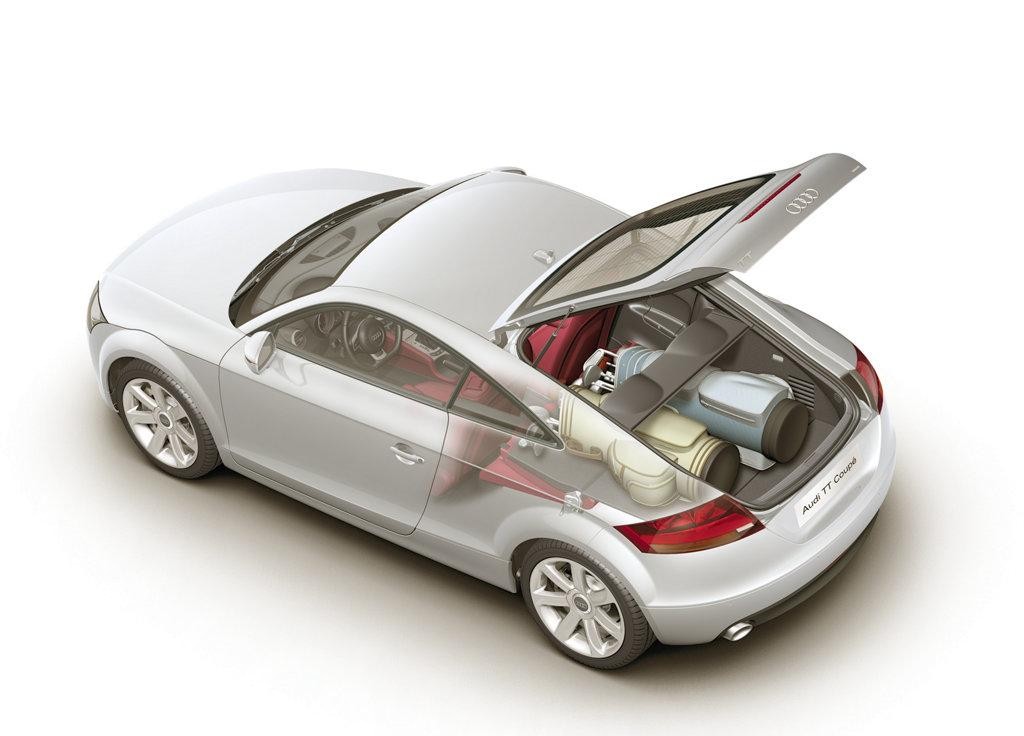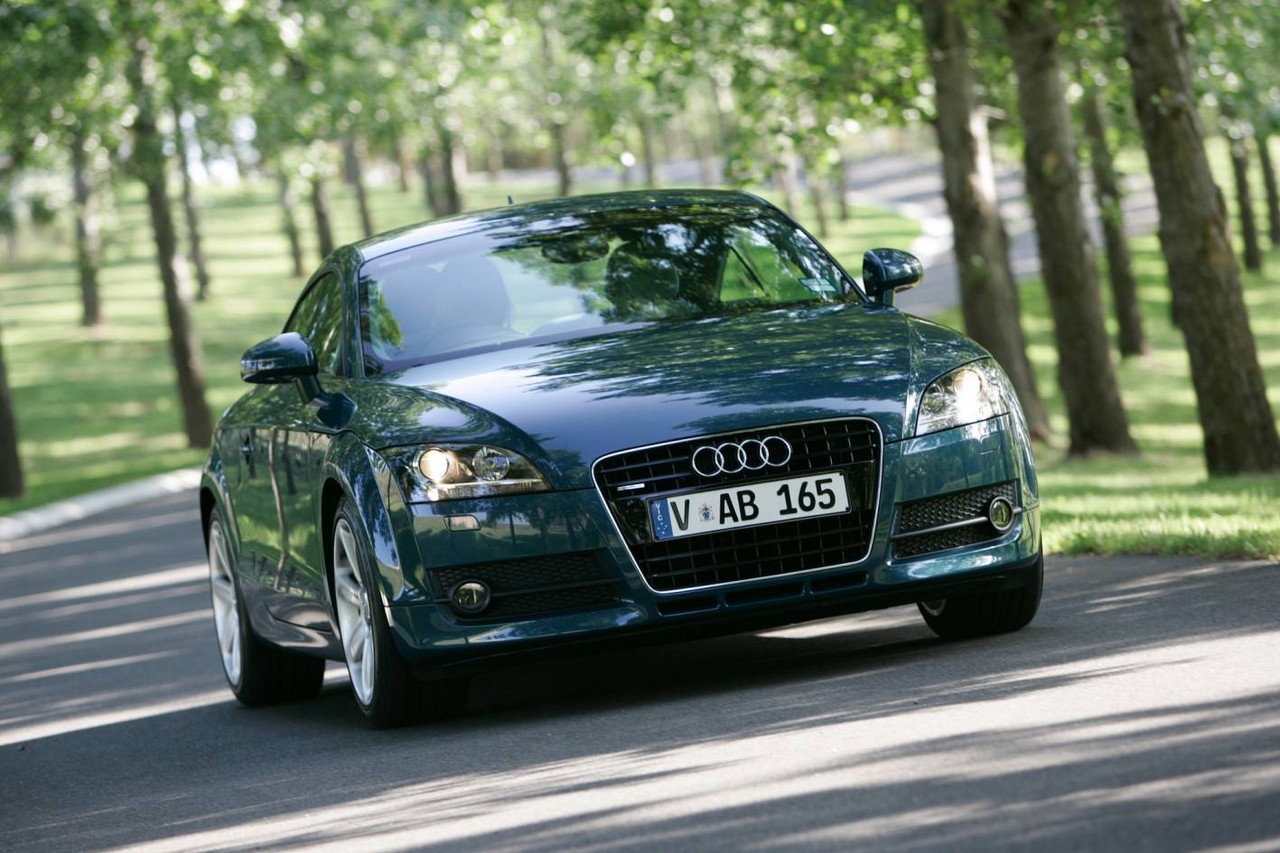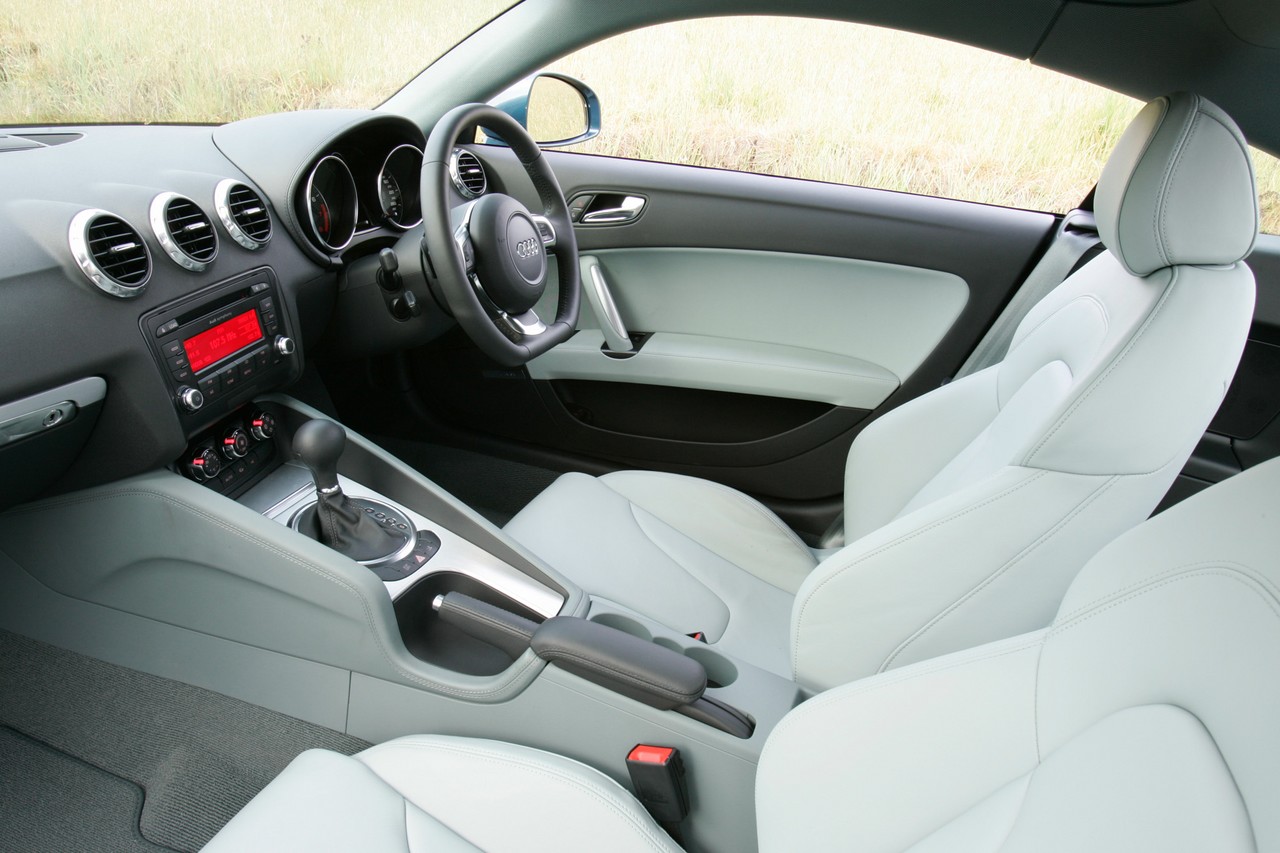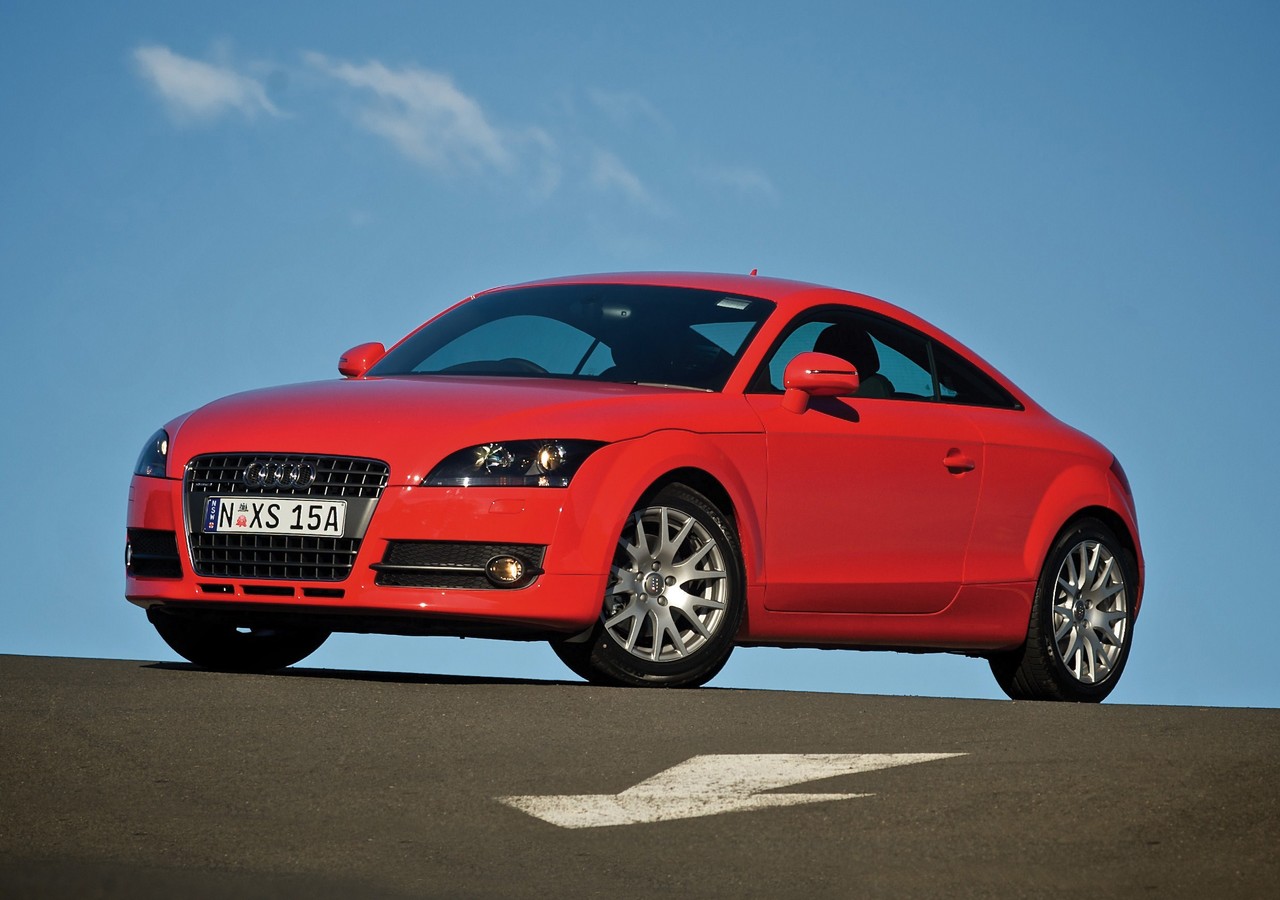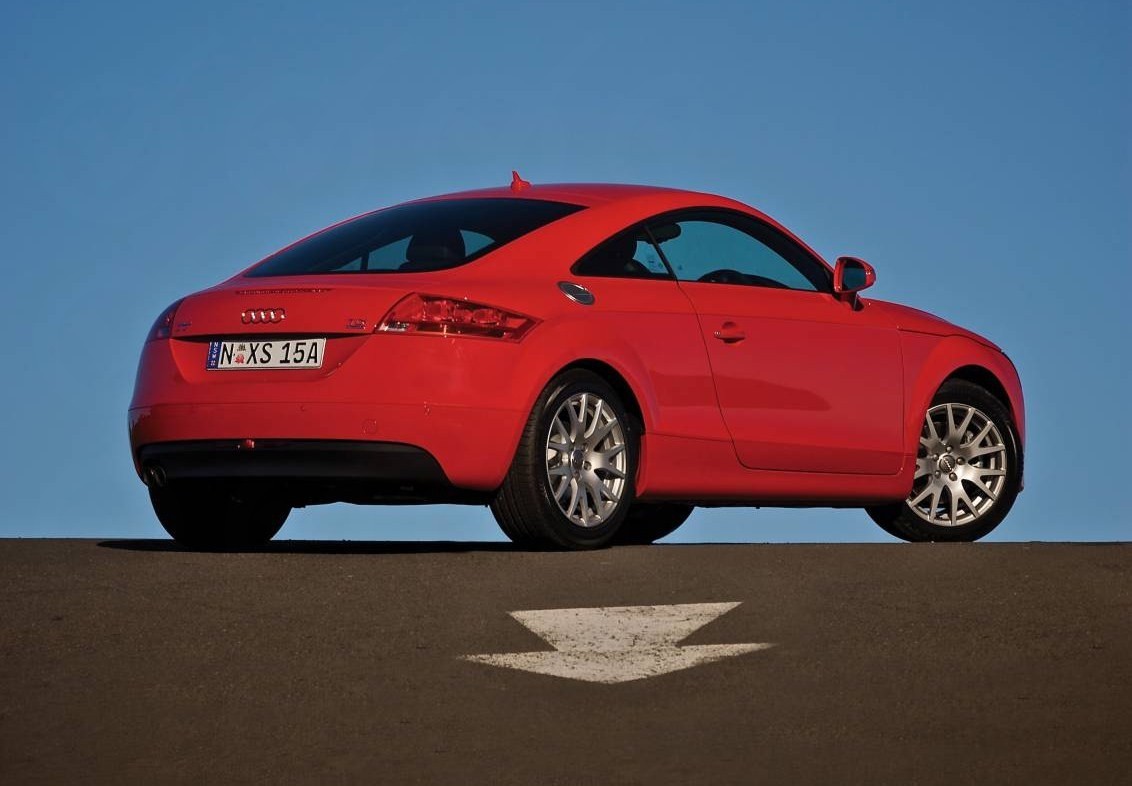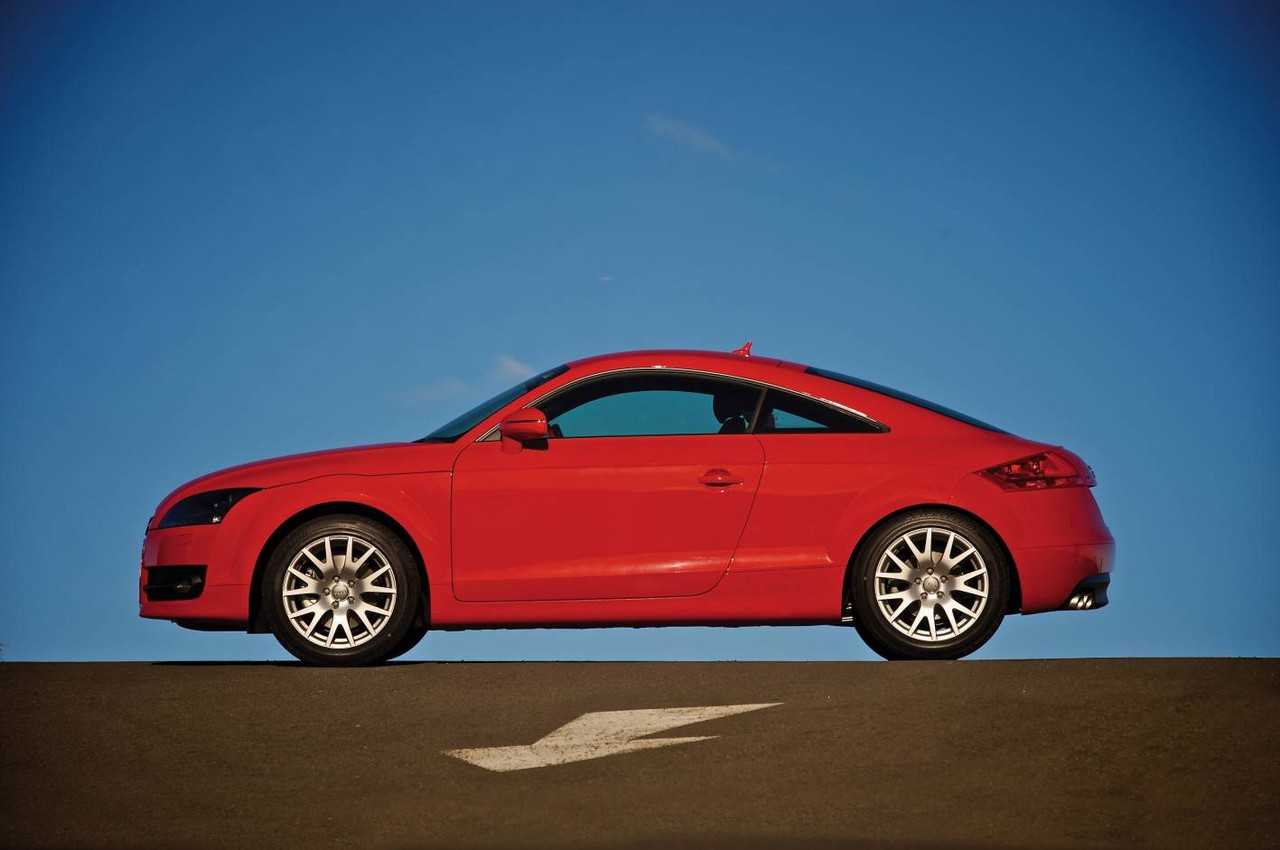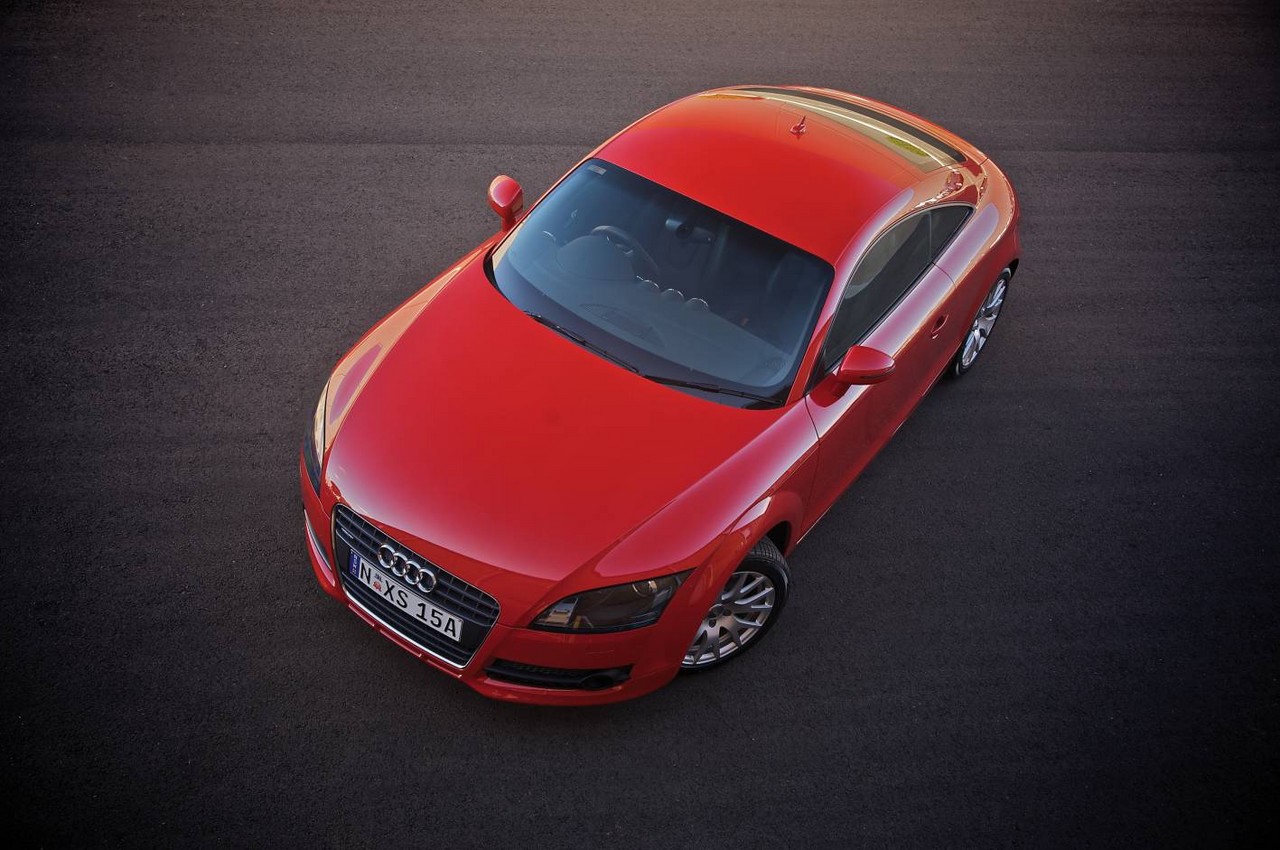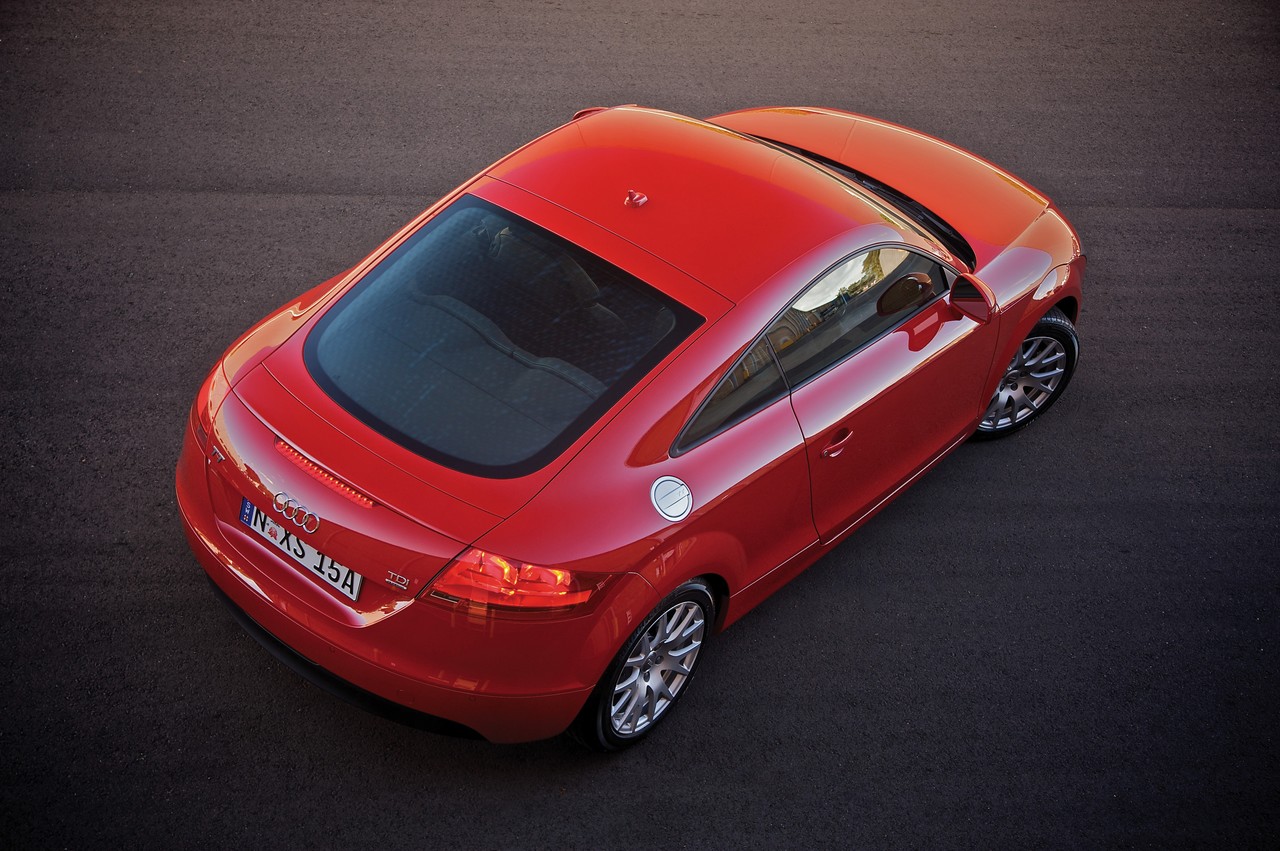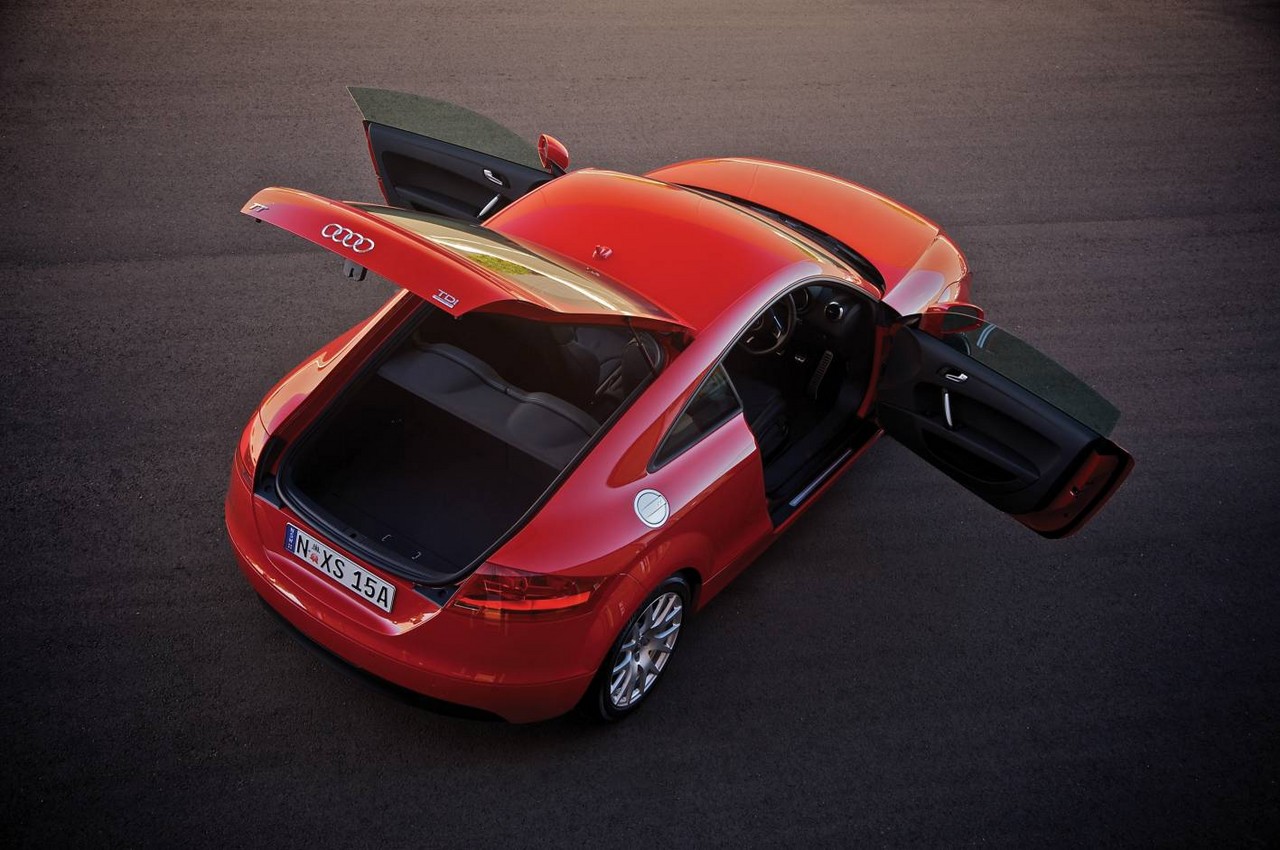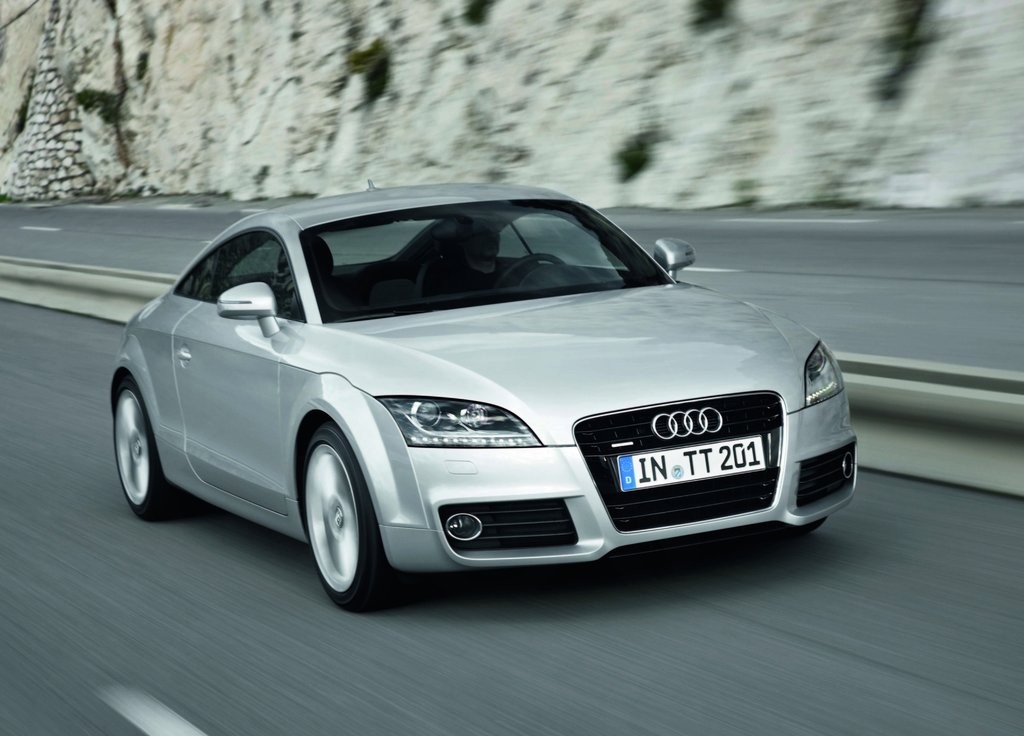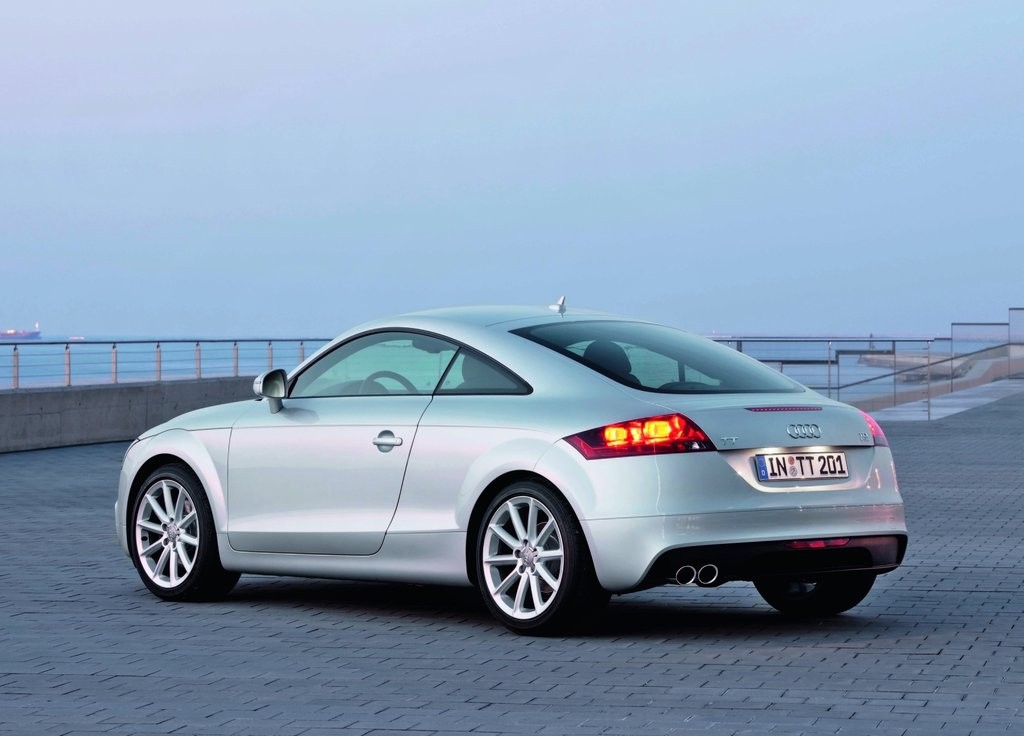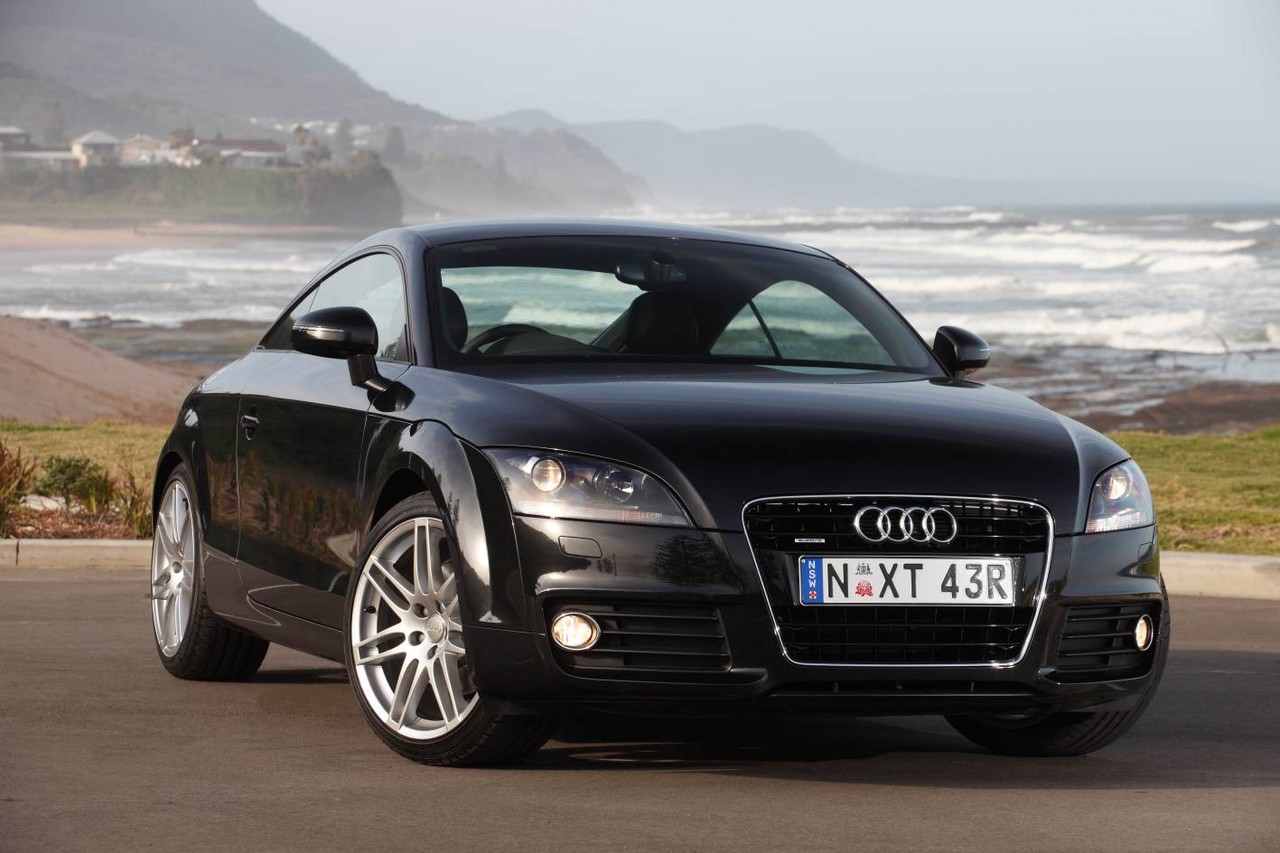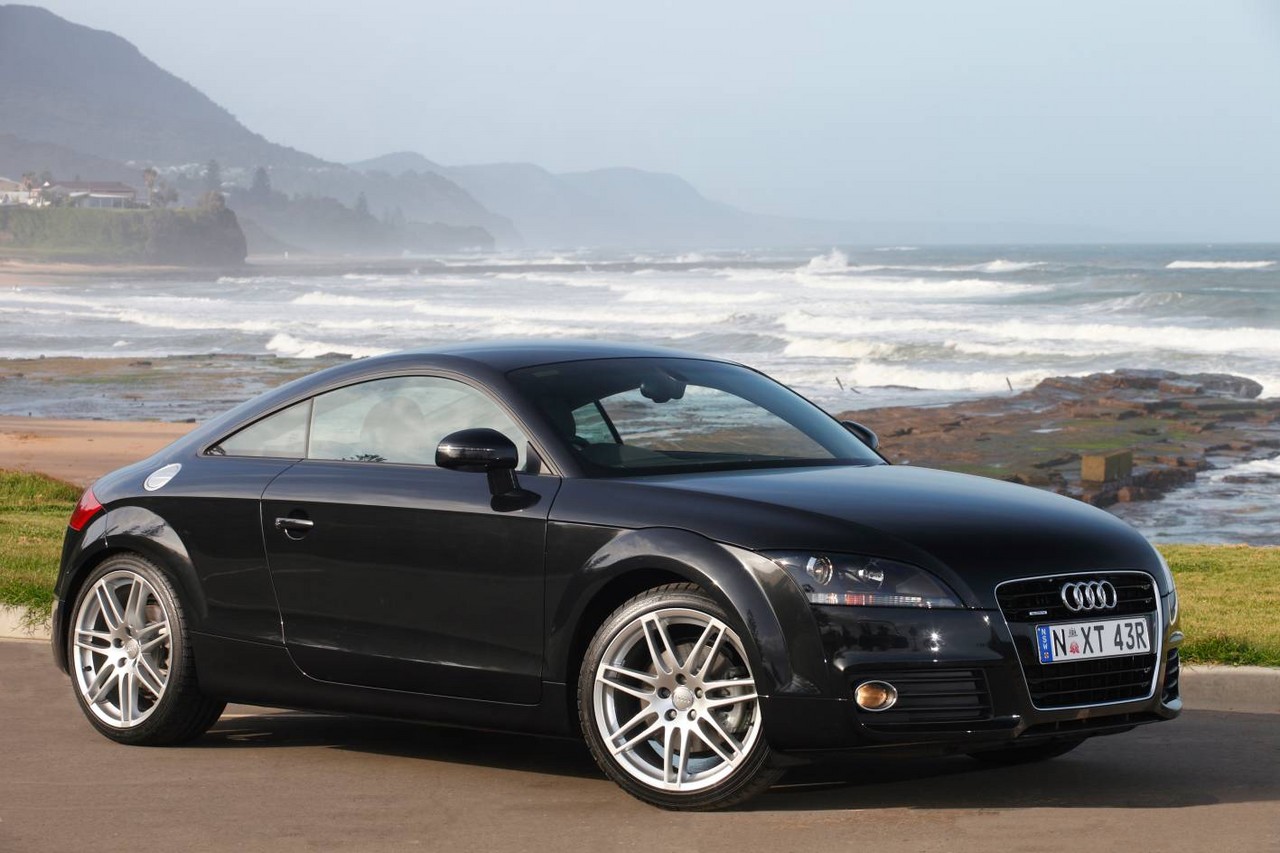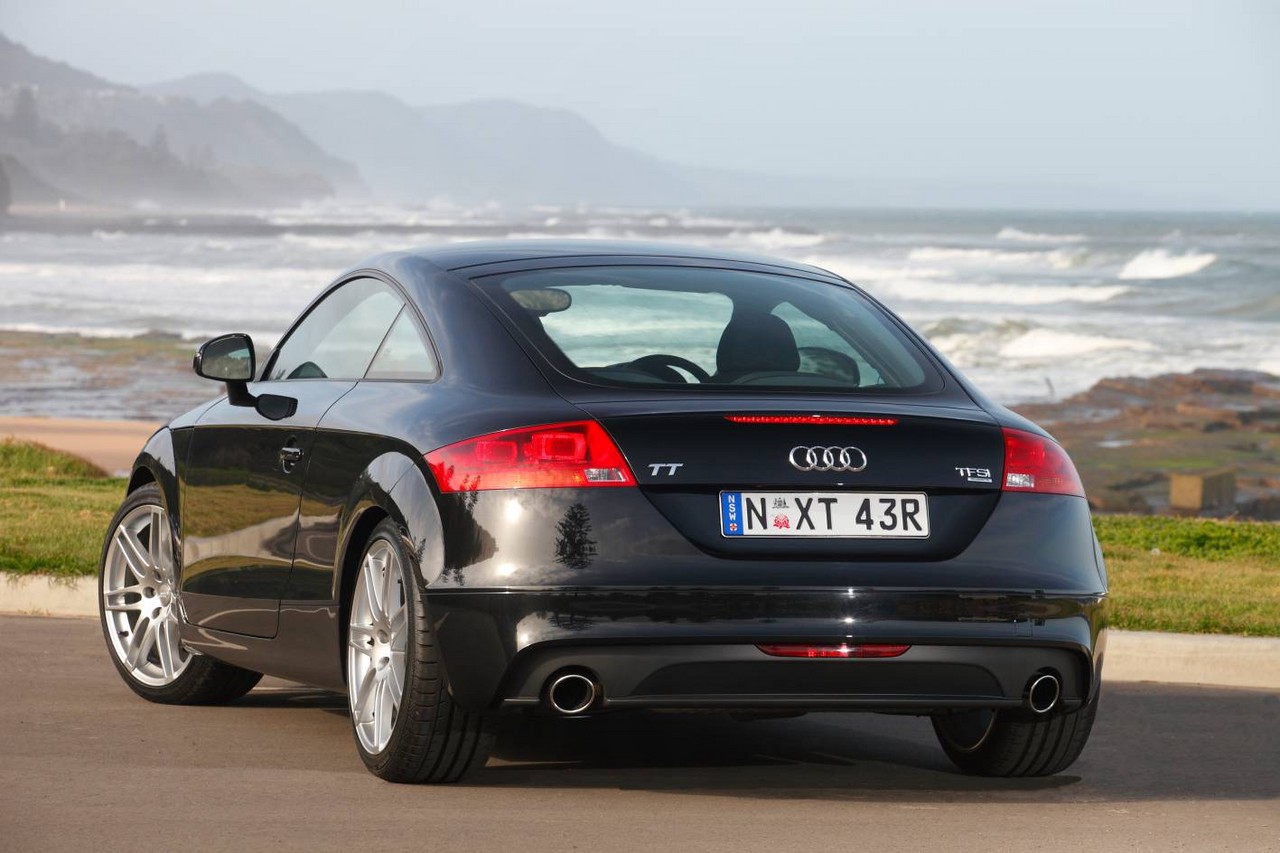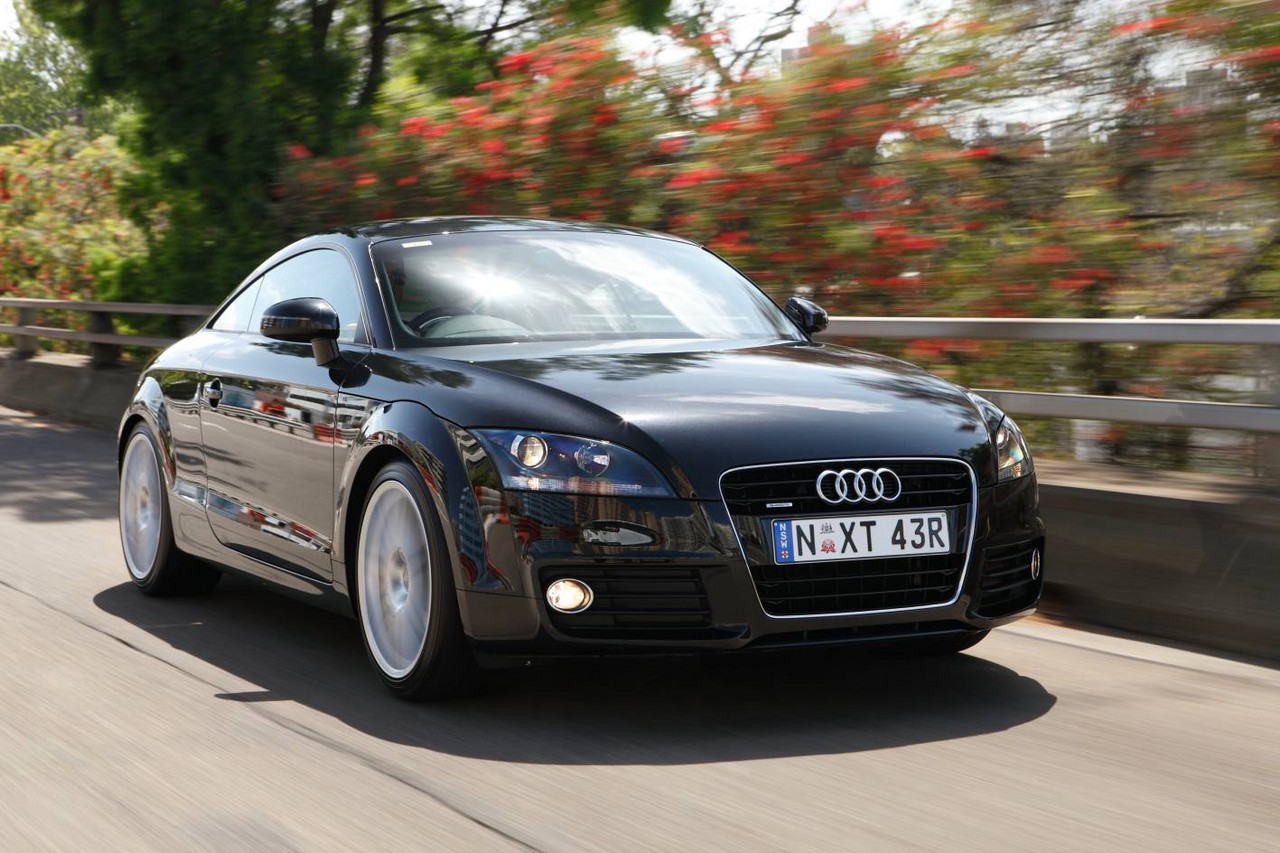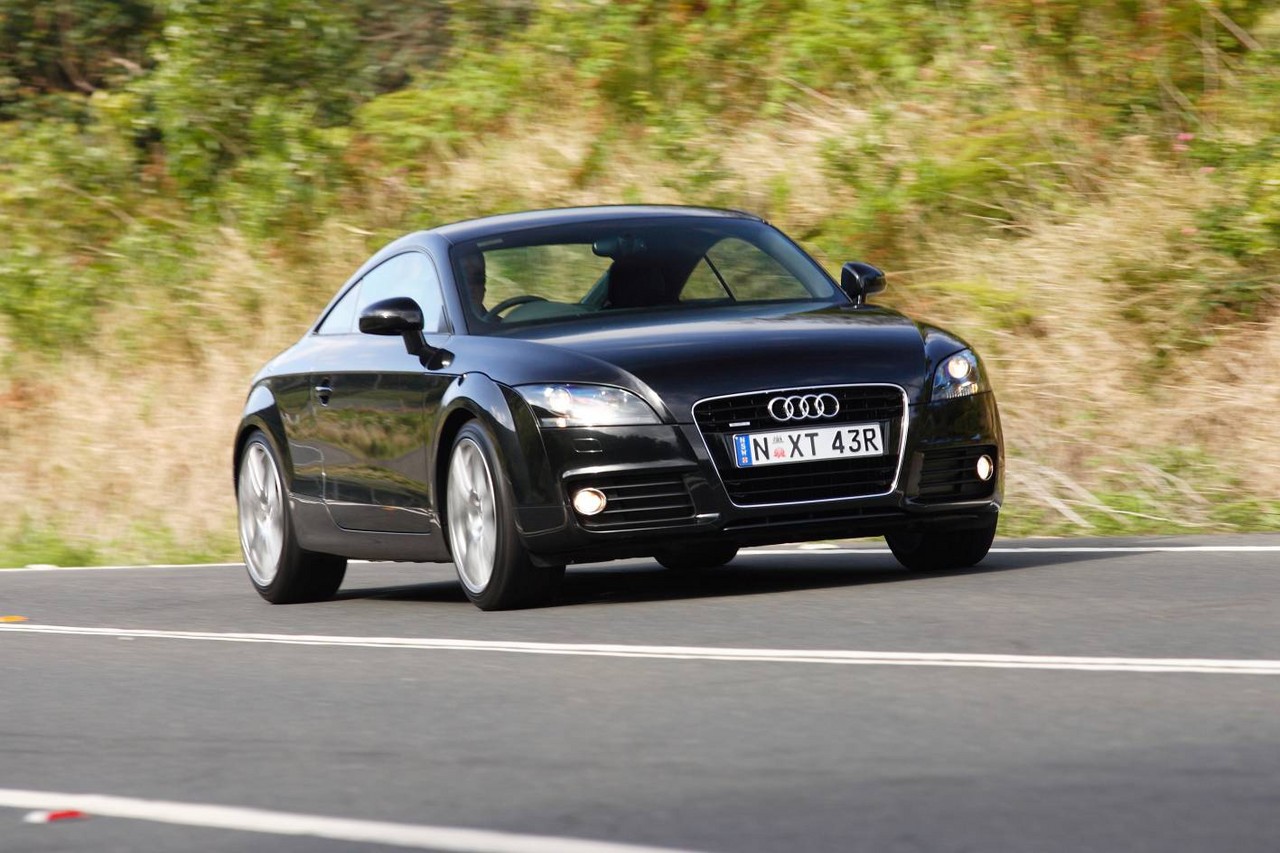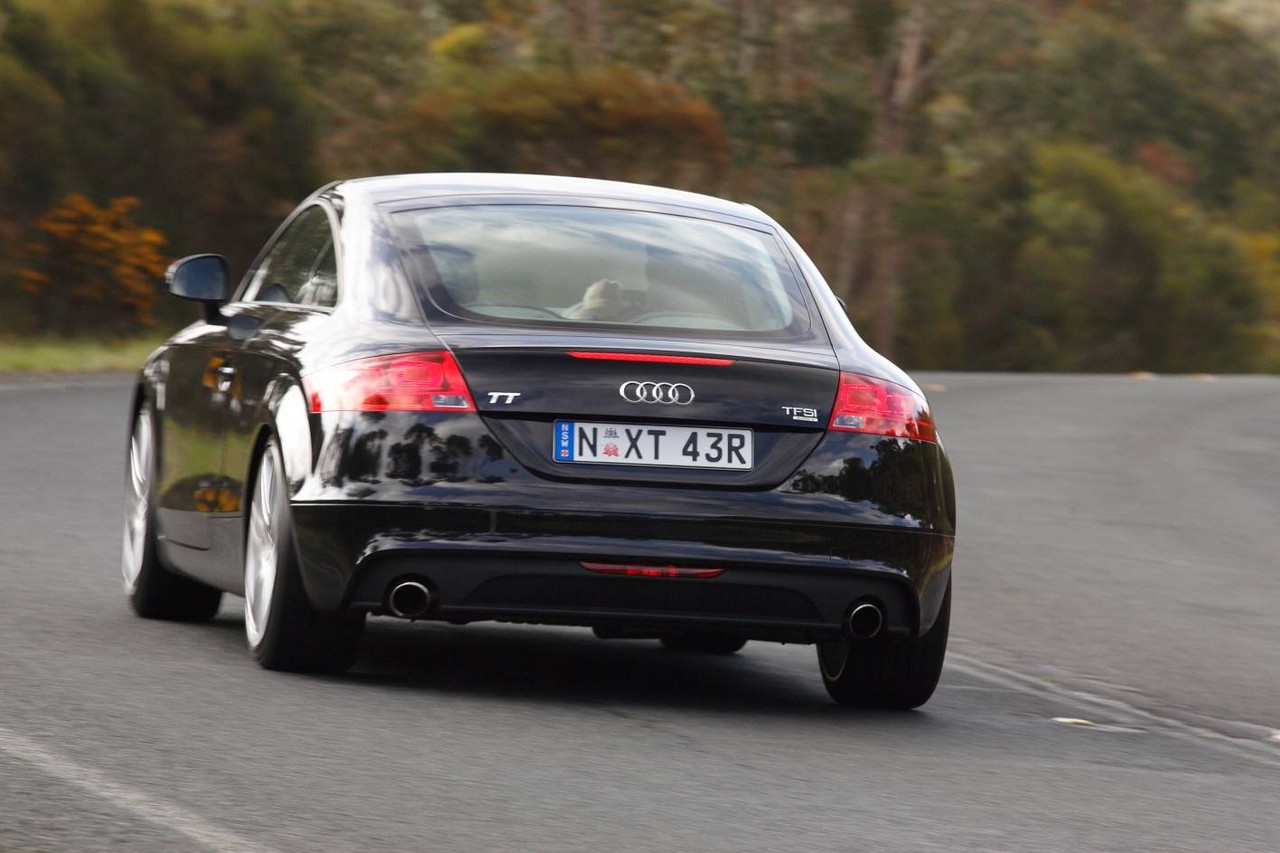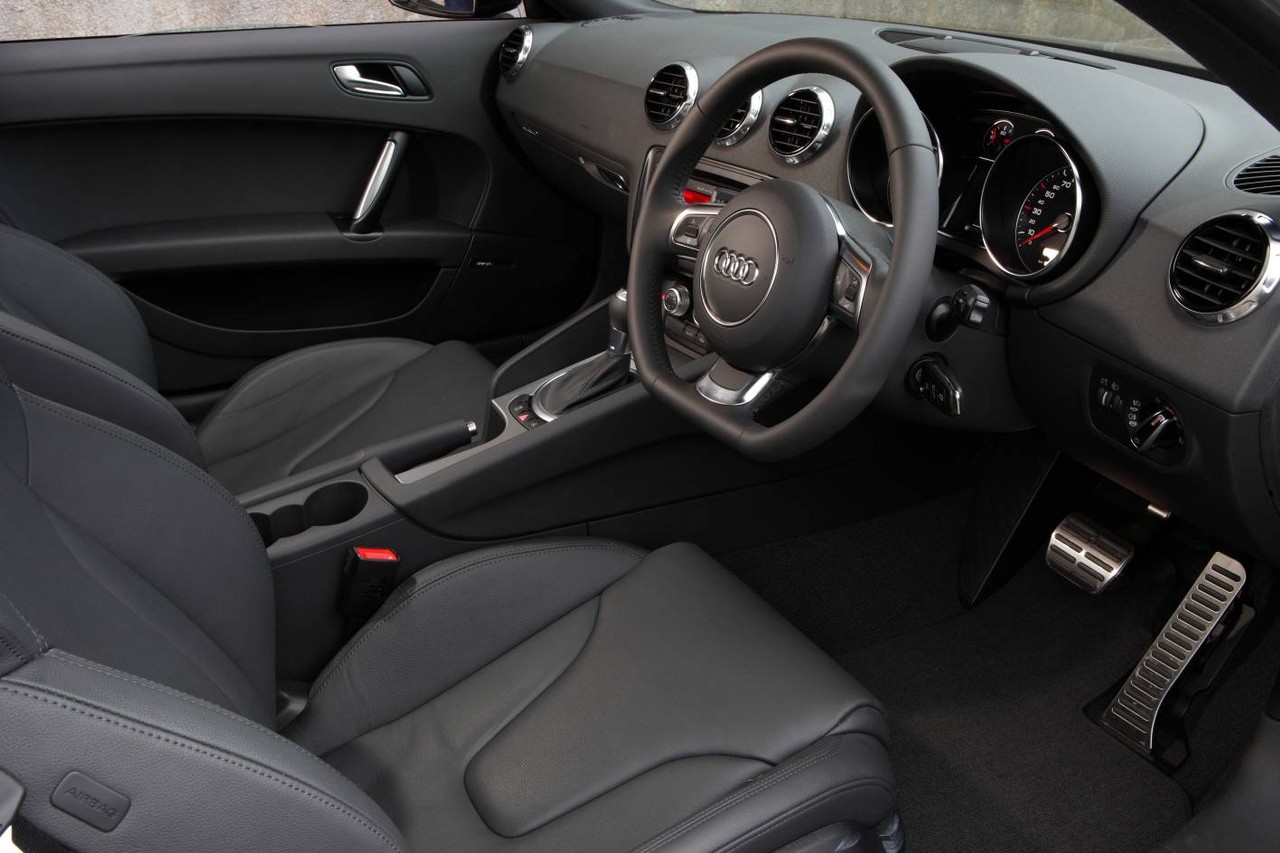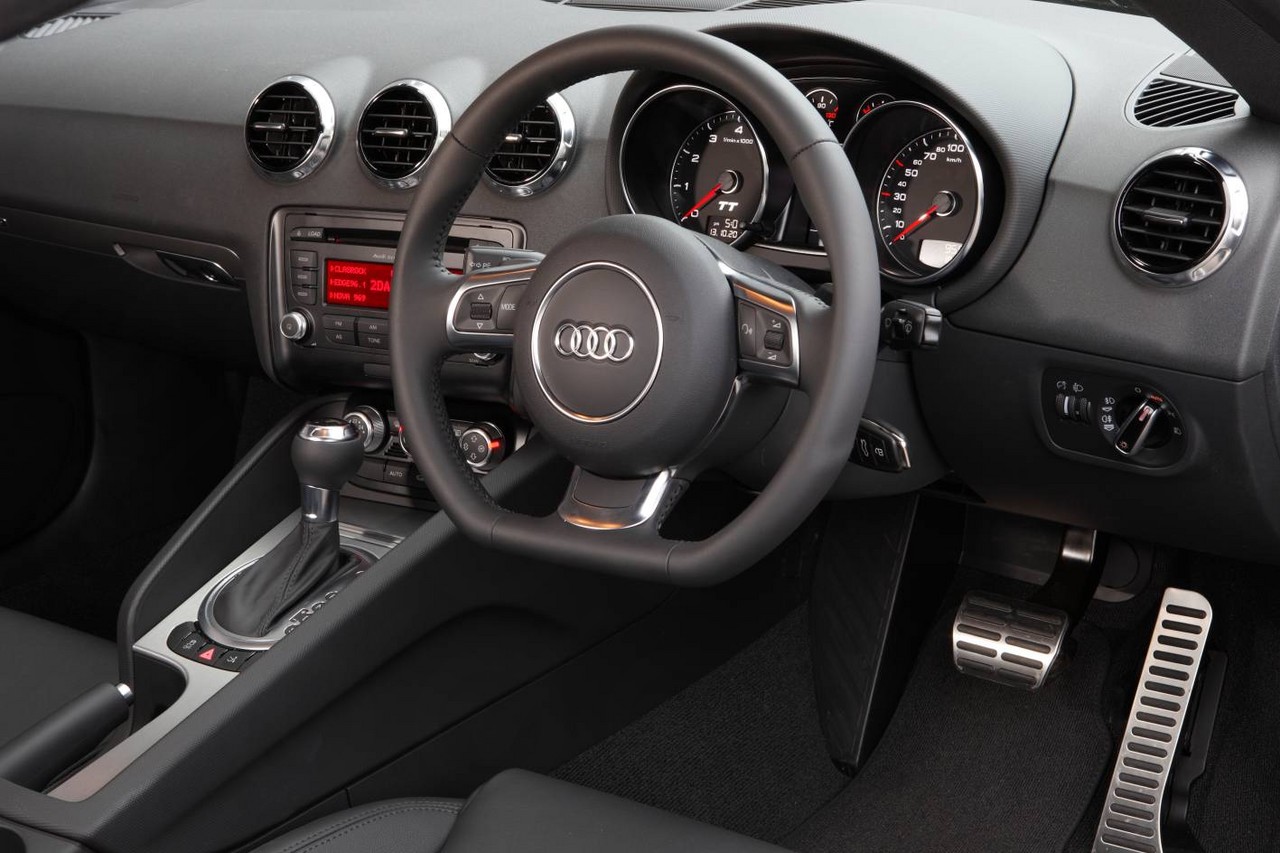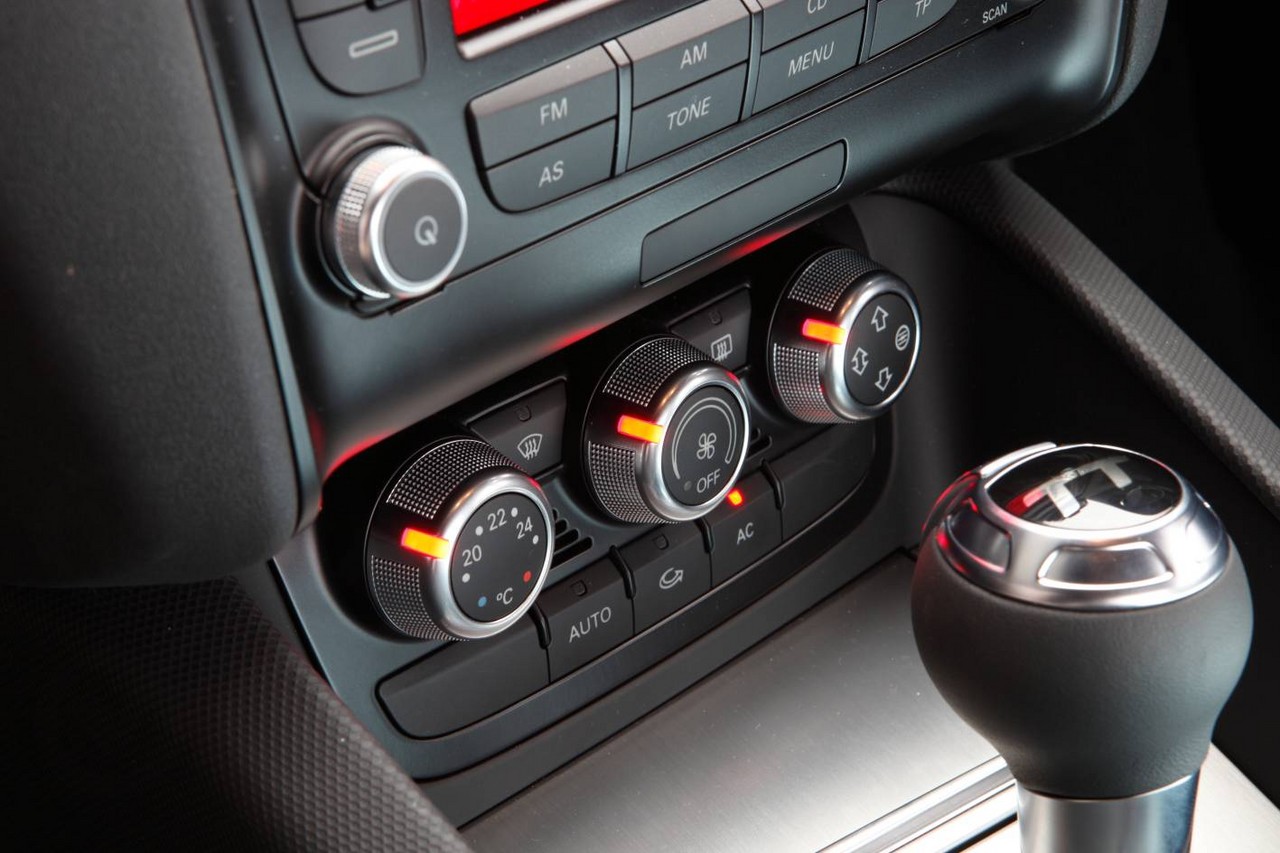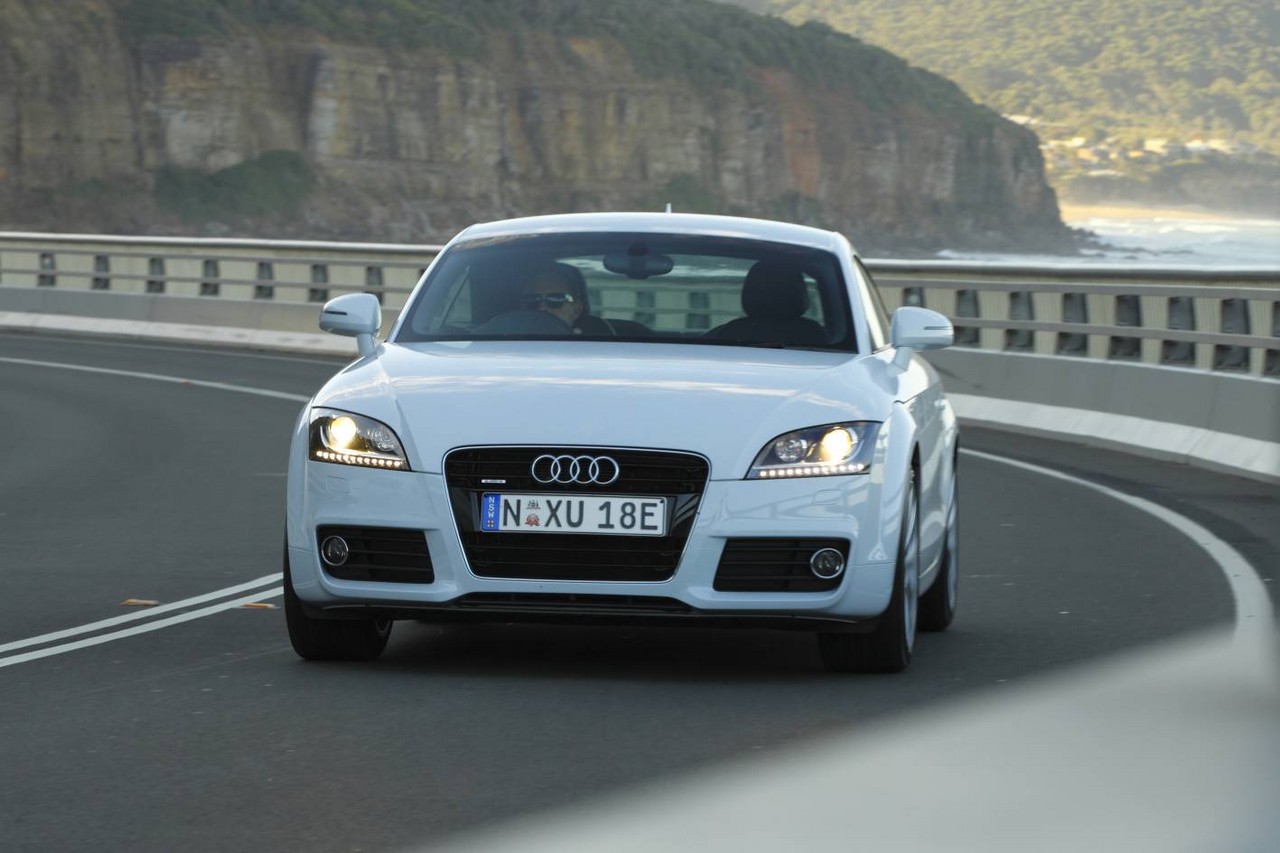
- Fuel-efficient drivetrains
- Competent, balanced handling
- High standard of interior fit and finish
- Steering lacks precision
- Poor rear seat space
- DSG could provide jerky gearshifts due to excessive wear in the bushings of solenoid valves within the Mechatronic unit
Review: Audi 8J.I TT Coupe (2006-10)
Overview
Released in November 2006, the Audi 8J Series I (8J.I) TT Coupe was a two-door, four-seat coupe. Manufactured in Gyor, Hungary, the Audi 8J TT Coupe was initially available with either a 2.0-litre turbocharged four-cylinder engine (the ‘2.0 TFSI’ variant) or a 3.2-litre petrol V6 (‘3.2’). In July 2009, the range was expanded with the introduction of the 1.8 TFSI and 2.0 TDI variants; the full range is given in the table below.
| Variant | Drive | Years | Engine | Trans. | Peak power | Peak torque |
|---|---|---|---|---|---|---|
| 1.8 TFSI | FWD | 2009-10 | 1.8-litre CDAA turbo petrol I4 | 6sp man. | 118 kW at 4500-6200 rpm | 250 Nm at 1500-4500 rpm |
| 2.0 TDI | quattro | 2009-10 | 2.0-litre CBBB turbo-diesel I4 | 6sp man. | 125 kW at 4200 rpm | 350 Nm at 1750-2500 rpm |
| 2.0 TFSI | FWD | 2006-10 | 2.0-litre BWA/CCZA turbo petrol I4 | 6sp man., 6sp DCT |
147 kW at 5100 rpm | 280 Nm at 1800-5000 rpm |
| quattro | 2009-10 | 2.0-litre BWA/CCZA turbo petrol I4 | 6sp DCT | |||
| 3.2 | quattro | 2006-10 | 3.2-litre BUB petrol V6 | 6sp DCT | 184 kW at 6300 rpm | 320 Nm at 2500-3200 rpm |
Body and dimensions
The 8J TT Coupe was based on Volkswagen’s PQ35 platform which also underpinned the Volkswagen Mk.5 Golf . Compared to the Audi 8N TT Coupe , however, the 8J TT Coupe was 137 mm longer (at 4178 mm), 14 mm narrower (1842 mm), 2 mm lower (1352 mm) and had a 49 mm longer wheelbase (2468 mm). Furthermore, the 8J TT Coupe utilised Audi’s Space Frame design system such that 69 per cent of its superstructure was made of aluminium, with the remaining 31 per cent of steel components located at the rear end of the vehicle to provide a better weight distribution.
Suspension
The Audi 8J TT Coupe had MacPherson strut front suspension with transverse links and four-link independent rear suspension.
quattro and electronic differential lock
The Audi 8J TT Coupe’s quattro system utilised a second generation Haldex electro-hydraulic limited-slip coupler (LSC) which consisted of a wet multi-plate clutch, a hydraulic pump and an electronically-controlled throttle valve. In normal conditions, 90 per cent of the engine’s torque was directed to the front wheels. If traction was lost, however, up to 50 per cent of the engine’s torque could be directed to the rear wheels.
Models with the quattro system were also fitted with an electronic differential lock which could brake a spinning wheel to transfer torque to the opposing front wheel (i.e. cross axle torque transfer). As such, the inside front wheel could be braked when cornering to reduce understeer.
Safety equipment
Standard safety equipment for the Audi 8J.I TT Coupe included dual front airbags, front side airbags, ABS, electronic brake force distribution, brake assist, electronic stability control, traction control and front seatbelts with load limiters and pretensioners.
Features
Standard features for the Audi TT Coupe 1.8 TFSI included 17-inch alloy wheels, a six speaker stereo with a CD player and MP3-compatibility, climate control air conditioning, leather seats, Bluetooth connectivity, front fog lamps, automatic headlights, rain-sensing wipers, 50/50 split and folding rear seats, a leather-wrapped steering wheel, remote central locking, power windows and heated mirrors, tilt and telescopic steering wheel adjustment, courtesy lamps, an electrochromatic rear view mirror, trip computer and an immobiliser.
The TT Coupe 2.0 TFSI and 2.0 TDI were further equipped with a six-disc CD player, while the TT Coupe 3.2 was distinguished by its 18-inch alloy wheels, Nappa leather upholstery and power adjustable front seats. Models fitted with the double clutch transmission were also fitted with steering wheel gearshift paddles.
Review: Audi 8J.II TT Coupe (2010-14)
Overview
Released in September 2010, the Audi 8J Series II (8J.II) TT Coupe introduced a revised range, fuel-saving technologies and a new quattro system. The TT Coupe 3.2 was discontinued and the 2.0 TFSI was fitted with a more powerful engine which featured the Audi Valve-lift System (AVS). The 1.8 TFSI and 2.0 TDI variants were also fitted with regenerative braking which utilised the vehicle’s kinetic energy when braking (or coasting) to charge the battery. From May 2012, the 1.8 TFSI and 2.0 TDI were available with a seven-speed double clutch transmission (DCT, or Audi’s ‘S-Tronic’).
Visually, the Audi 8J.II TT Coupe could be identified by its LED daytime running lights, chrome-ringed fog lights, larger front air vents, new tail-lights and a wider rear diffuser panel. Inside, there were new aluminium and gloss black inserts for the steering wheel, centre console and door trims.
| Variant | Drive | Engine | Trans. | Years | Peak power | Peak torque |
|---|---|---|---|---|---|---|
| 1.8 TFSI | FWD | 1.8-litre CDAA turbo petrol I4 | 6sp man. | 2010-14 | 118 kW at 4500-6200 rpm | 250 Nm at 1500-4500 rpm |
| 7sp DCT | 2012-14 | |||||
| 2.0 TDI | quattro | 2.0-litre CFGB turbo-diesel I4 | 6sp man. | 2010-14 | 125 kW at 4200 rpm | 350 Nm at 1750-2500 rpm |
| 7sp DCT | 2012-14 | |||||
| 2.0 TFSI | FWD, quattro |
2.0-litre CESA turbo petrol I4 | 6sp DCT | 2010-14 | 155 kW at 4300-6000 rpm | 350 Nm at 1600-4200 rpm |
quattro
The quattro models for the Audi 8J.II TT Coupe were fitted with a fourth-generation Haldex all-wheel drive system. Unlike its predecessors, fourth generation Haldex all-wheel drive systems could pro-actively engage the multi-plate clutch via a feeder pump when a loss of traction was anticipated. Previously, a difference in front and rear axle speeds – caused by wheelspin – was required to engage all-wheel drive.
Safety equipment and features
Compared to its 8J.I predecessor, standard safety equipment and features for the Audi 8J.II TT Coupe were largely unchanged.
Related links
